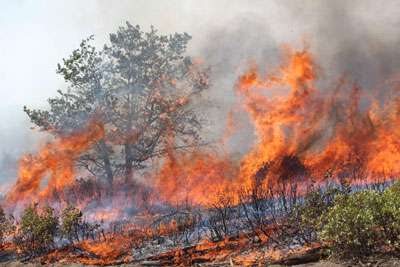Even in restored forests, extreme weather strongly influences wildfire's impacts

The 2013 Rim Fire, the largest wildland fire ever recorded in the Sierra Nevada region, is still fresh in the minds of Californians, as is the urgent need to bring forests back to a more resilient condition. Land managers are using fire as a tool to mimic past fire conditions, restore fire-dependent forests, and reduce fuels in an effort to lessen the potential for large, high-intensity fires, like the Rim Fire. A study led by the U.S. Forest Service's Pacific Southwest Research Station (PSW) and recently published in the journal Forest Ecology and Management examined how the Rim Fire burned through forests with restored fire regimes in Yosemite National Park to determine whether they were as resistant to high-severity fire as many scientists and land managers expected.
Since the late 1960s, land managers in Yosemite National Park have used prescribed fire and let lower intensity wildland fires burn in an attempt to bring back historical fire regimes after decades of fire suppression. For this study, researchers seized a unique opportunity to study data on forest structure and fuels collected in 2009 and 2010 in Yosemite's old-growth, mixed-conifer forests that had previously burned at low to moderate severity. Using post-Rim Fire data and imagery, researchers found that areas burned on days the Rim Fire was dominated by a large pyro-convective plume—a powerful column of smoke, gases, ash, and other debris—burned at moderate to high severity regardless of the number of prior fires, topography, or forest conditions.
"The specific conditions leading to large plume formation are unknown, but what is clear from many observations is that these plumes are associated with extreme burning conditions," says Jamie Lydersen, PSW biological science technician and the study's lead author. "Plumes often form when atmospheric conditions are unstable, and result in erratic fire behavior driven by its own local effect on surface wind and temperatures that override the influence of more generalized climate factors measured at nearby weather stations."
When the extreme conditions caused by these plumes subsided during the Rim Fire, other factors influenced burn severity. "There was a strong influence of elapsed time since the last burn, where forests that experienced fire within the last 14 years burned mainly at low severity in the Rim Fire. Lower elevation areas and those with greater shrub cover tended to burn at higher severity," says Lydersen.
When driven by extreme weather, which often coincides with wildfires that escape initial containment efforts, fires can severely burn large swaths of forest regardless of ownership and fire history. These fires may only be controlled if more forests across the landscape have been managed for fuel reduction to allow early stage suppression before weather- and fuels-driven fire intensity makes containment impossible. Coordination of fire management activities by land management agencies across jurisdictions could favor burning under more moderate weather conditions when wildfires start and reduce the occurrences of harmful, high-intensity fires.
More information: www.treesearch.fs.fed.us/pubs/46372
Journal information: Forest Ecology and Management
Provided by USDA Forest Service




















